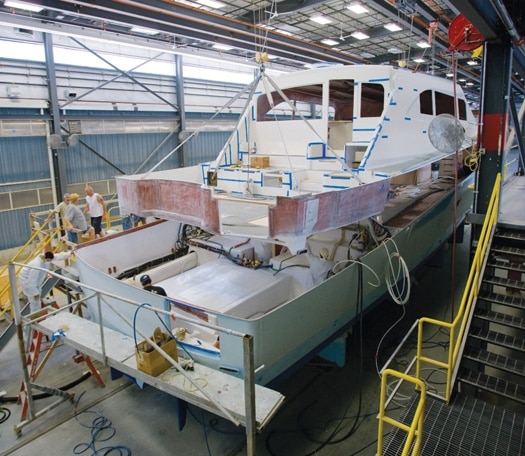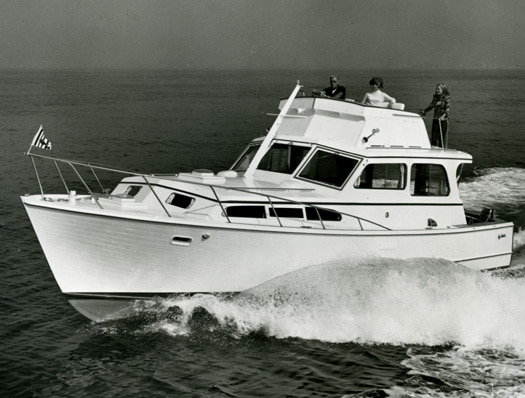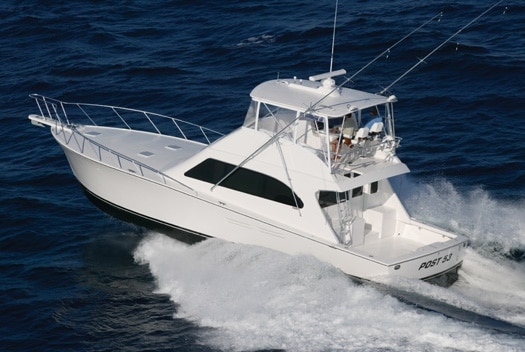
jersey1.jpg
I came to work with my father during the summer and weekends. That’s when I was seven or eight. By age eleven, I was pushing a broom. By fourteen, I was driving the trash truck. Imagine that,” said Viking Executive V.P. of sales and marketing Pat Healey as he recollected his early days at the New Jersey-based family-owned company he now heads up.
Much has changed since his father Bill and uncle Bob started the business in 1960. And we can follow how the Healeys, along with many other New Jersey boatbuilders, were able to carve out an important place in the industry by looking at what took place in the years just after World War II.
A lot happened in 1946. Early in the year, the scientists of Project Diana bounced radar waves off the moon, measuring the distance between here and there. The United Nations met for the first time, Ben Hogan won the PGA Championship, and the Bikini bathing suit went on sale in Paris. Closer to home, however, four guys from the Garden State were creating boatbuilding history.
Exactly who built the first Jersey-style sportfisherman is still a topic of dispute up and down the Shore. But everyone agrees that, in this case, Egg Harbor really did come before the chicken when a quartet of knowledgeable and experienced boatbuilders and boating enthusiasts had an idea for a boat company.
The inspiration for Egg Harbor may have started in the rumrunning days, when the creeks and backwaters were filled with “honest men” just looking to make ends meet. Back then Ventnor Boat Works, of Ventnor City, New Jersey, was known for its sleek, radically modern runabout and racing-boat designs. Think Riva or Chris-Craft with a New Jersey attitude.
But when the Second World War broke out in Europe, Ventnor moved its building facility to Atlantic City, and because of the war effort, there was a void in recreational boatbuilding in the southern part of the state until 1945. And that was all the room the Jersey Boys needed.
They were a diverse group but connected to the same idea: passion for boats and being out on the water. Russell Post and John Leek had already started their own business and were busy building rowboats out of a rented space in Egg Harbor City. Phil Boyd had also done his share of “backyard boatbuilding” by the time he and the others got together. And Harold Care, aka “Pee Wee,” was by far the most eccentric of the four.
“They were all talented guys-good boatbuilders-and we have to thank them for what they did for our business,” recalls Bill Healey, who along with his brother Bob was one of the founders of Viking Yachts. “Pee Wee was a trick water-skier and was also one of the original riders in the diving-horse show on the Steel Pier at Atlantic City they had there in 1928. That’s the kind of guy he was.”
“I was there from the beginning,” says Jack Leek, whose father John started Egg Harbor with Russell Post. “I was in high school when my dad and Russell went into business. Boyd, who was the accountant and bookkeeper, joined them a year later. Then Care finally kicked in his share.” Care reportedly sold some property in order to join the others.
Post and Leek opened the doors for business in 1946. And it is part of boatbuilding legend that Post sold his car to pay for the cedar that went into their first boat, a 28-foot, carvel-built, round bilged skiff. Leek and Ted Haggas, a respected local Jersey designer, and one of those responsible for the original Jersey Skiff boats, drew her lines. “The mayor of Egg Harbor City bought that first boat for $3,000,” Leek remembers. However, the company’s imprint on the sportfishing scene, and the boat that literally created the brand, was the introduction of the 37-foot, cedar-on-oak-framed Egg Harbor Convertible, designed by George Stadel in the early 1960s. “The detail was all there. It was just a good boat,” Healey said. The design has lasted over 40 years, going from wood to fiberglass in the 1970s.

| | |
“If you’re asking if they were original designers, well let’s look at it this way,” said Bill Schell, who along with Charlie Walters, purchased Post Yachts in 1975 and is the current owner of the company. “You had the Rybovichs in Palm Beach and lots of guys up and down the coast, especially in the Carolinas, that were coming up with boats designed for running in adverse local conditions. No matter who was building, you took a little bit of sheer from something you saw here and a bit of hull from there and then added your own ideas.” If the Jersey design could be called anything, it was American: tough, durable, and a good value.
The local conditions Schell had mentioned are known well to veteran mariners down the Shore and include inlets such as Shark River, Manasquan, and Absecon, where getting to and from the sea in difficult sea states could challenge even local boats and skippers. For visiting boaters, well, they got a quick lesson in seamanship.
“It was all about running the inlets. That’s how the first boats were designed,” Leek said. “Narrow in the bow with no more than a nine-foot beam or so.”
Through the 1950s, the Haggas and Stadel boats, and later designs by Phil Bolger and Dave Martin, one of the best-known of the Jersey designers, established Egg Harbor as builders of well-designed boats that were also good performers with even modest power. “Dave and I started working at Egg as woodworkers. Russell was a damn good production mill worker,” says Leek. “Call it engineering, call it what you like, but that was his end of it. He was pretty weight-conscious and those first boats were light and fast.”
But as can happen in a partnership, especially one with distinct personalities, Post and Leek had been going toe to toe over this and that. By 1948, John Leek, Sr., sold his shares of the company to Boyd and went out on his own to form Pacemaker. Together with his brother Cecil, they opened the business in Lower Bank early in 1949. “That first boat was a carvel-planked 29-footer using Jersey cedar on oak frames,” said Jack Leek. “My brother Donald and I joined the company in 1950 when we moved up to a 33-footer and then onto a 36 and a 40. The customers wanted to grow and so did we.” Post would also end his Egg days in 1957 when he left to set up Post Yachts.
“Russell was like that, you know,” says Schell. “He knew when something was over and it was time to move on.” Post opened his yard in 1957 in Mays Landing on the banks of the Great Harbor River and decided from day one that he would build quality and not quantity, a statement that has become the Post mantra. His design called for a high bow, eliminating the trunk cabin style, and a gentle sheer that ended at the transom. “If you look at our design, even from the early days, it hasn’t changed much. It’s what we feel makes our boats special,” said Post’s president, Ken Jensen. Post launched its first boat, a 34-footer, in 1958. And as he did during his time at Egg Harbor, Post took each and every one that came out of the yard for its initial sea trial. Post stayed with the company for almost 20 years before selling it to Schell and Walters in 1975, and continued as a consultant for several years afterwards.

| | |
In the early 1960s, finding itself in financial trouble, Egg Harbor sold its stock to Pacemaker and became part of the Leek organization. While the two brands were kept separate, they were a formidable pair and became one of the premier stateside boatbuilders. Egg would grow throughout the ’60s and ’70s, building boats ranging in size from 30 to 48 feet and converting from wood construction to fiberglass in the early 1970s. And while wood boats were built right through the mid-1960s, some other Jersey Boys would take the new boatbuilding material in another direction.
“We felt that the boating industry was coming on so we bought our property here in New Gretna in 1960 and opened a marina,” Bill Healey said. “I was in the construction business working with my dad as an ironworker. My brother Bob, who graduated from law school, put together some leases to develop the property you know, have the marina and homes. But after that first year with the boats, Bob and I forgot about the homes.” Then in 1964, the Healeys bought out the assets of Petersen-Viking, a small boatbuilder with whom they did business and whose line included several 37-foot wooden cruising and sportfishermen. By 1971, the first Viking fiberglass boat, a 33-foot convertible, came off the production line. Today, under Bill’s son Pat, Viking Yachts has become one of the premier builders of sportfishermen in the world. “It started as a family business and will always continue as one,” says the younger Healey as Viking gets ready to launch its striking 82 Convertible.
By the 1970s, fiberglass had replaced wood as the material of choice, and Jack Leek and son John III saw the opportunity to build on the family legacy. The Leeks could trace their boatbuilding lineage back to the beginning of New Jersey boatbuilding, in the 1700s, so it was a proud moment when Ocean Yachts launched its first boat, a 40-foot fiberglass convertible, in 1977. “Our sense of heritage, of having the family name in the boatbuilding business for so long, is built right into the laminate as much as is our quality and dedication to our owners,” said John Leek IV, or J4 as he’s known in the industry. J4’s most personal boatbuilding statement was the launch of Ocean’s 37 Billfish in 2006, a project he envisioned while still in engineering school. And there will be more.
Despite all of this boatbuilding, Egg Harbor found itself in and out of financial trouble until 1990 when it went into Chapter 11 receivership. By 1992, and with the court’s approval, Egg once again started up the production line. Problems once again visited the company and it finally folded in 1997.
However, the Egg Harbor story wasn’t over yet. “I grew up on a chicken farm not far from where my plant is now and during the summers, I figured out a way to increase the production of wood cabinets by making them uniform instead of different sizes,” said Egg Harbor native Dr. Ira Trocki, the current president and CEO of Egg Harbor Yachts. Trocki’s intuitive ability to see “another way to do things” has contributed to his success as a surgeon, with his investments, and also as a boatbuilder. “I used to walk by the plant when I was a kid and say to myself that one day I would own it,” he said. That day came in 1999. After a couple of phone calls, he made an offer for the company. Since then, Trocki has invested $10 million into Egg Harbor and has also acquired Predator, Topaz, and Davis. “I look at these boats as being works of art,” Trocki said. “I’m glad I can be a part of it, to take the business into a new century and be successful.”
The next time you see a Jersey boat go by, take a close look at her sleek, low profile. Try to imagine the vision that a group of entrepreneurial boating enthusiasts had when they first set out to make their marks in the world of boatbuilding. And no matter which Jersey boat you prefer, you’ll have one of those Jersey Boys to thank for all the pleasure, excitement, quality, and heritage that can be summed up in a lyric from native son Bruce Springsteen:
‘Cause nothing matters in this whole wide world When you’re in love with a Jersey girl.









